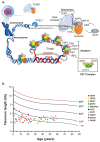Recent advances in understanding telomere diseases
- PMID: 36311538
- PMCID: PMC9586155
- DOI: 10.12703/r/11-31
Recent advances in understanding telomere diseases
Abstract
Germline genetic defects impairing telomere length maintenance may result in severe medical conditions in humans, from aplastic anemia and myeloid neoplasms to interstitial lung disease and liver cirrhosis, from childhood (dyskeratosis congenita) to old age (pulmonary fibrosis). The molecular mechanisms underlying these clinically distinct disorders are pathologically excessive telomere erosion, limiting cell proliferation and differentiation, tissue regeneration, and increasing genomic instability. Recent findings also indicate that telomere shortening imbalances stem cell fate and is associated with an abnormal inflammatory response and the senescent-associated secretory phenotype. Bone marrow failure is the most common phenotype in patients with telomere diseases. Pulmonary fibrosis is a typical phenotype in older patients, and disease progression appears faster than in pulmonary fibrosis not associated with telomeropathies. Liver cirrhosis may present in isolation or in combination with other phenotypes. Diagnosis is based on clinical suspicion and may be confirmed by telomere length measurement and genetic testing. Next-generation sequencing (NGS) techniques have improved genetic testing; today, at least 16 genes have been implicated in telomeropathies. NGS also allows tracking of clonal hematopoiesis and malignant transformation. Patients with telomere diseases are at high risk of developing cancers, including myeloid neoplasms and head and neck cancer. However, treatment options are still limited. Transplant modalities (bone marrow, lung, and liver) may be definitive to the respective organ involvement but limited by donor availability, comorbidities, and impact on other affected organs. In clinical trials, androgens elongate telomeres of peripheral blood leukocytes and improve hematopoiesis. Further understanding of how telomere erosion impairs organ function and how somatic mutations evolve in the hematopoietic tissue may help develop new strategies to treat and prevent telomere diseases.
Keywords: aplastic anemia; dyskeratosis congenita; liver cirrhosis; myeloid neoplasm; pulmonary fibrosis; telomerase; telomere.
Copyright: © 2022 Calado RT et al.
Conflict of interest statement
The authors declare that they have no competing interests.No competing interests were disclosed.No competing interests were disclosed.
Figures


References
Publication types
LinkOut - more resources
Full Text Sources
